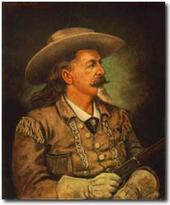Buffalo Bill
William Frederick "Buffalo Bill" Cody (February 26, 1846 – January 10, 1917) was an American soldier, bison hunter and showman. He was one of the most colorful figures of the Old West, and mostly famous for the shows he organized with cowboy themes.
He was born at his family's farmhouse in Scott County, Iowa, on February 26, 1846, near Le Claire, to Isaac and Mary Cody. When Cody was 7, the family relocated to Kansas, moving into a large log cabin on land that they had staked there.
Cody's father believed that Kansas should be a free state. While giving an anti-slavery speech at the local trading post, he so inflamed the supporters of slavery in the audience that they formed a mob and one of them stabbed him. Cody helped to drag his father to safety, although he never fully recovered from his injuries. The family was constantly persecuted by the supporters of slavery, forcing Isaac Cody to spend much of his time away from home. His enemies learned of a planned visit to his family and plotted to kill him on the way. Cody, despite his youth and the fact that he was ill, rode 30 miles to warn his father. Cody's father died in 1857 from complications from his stabbing.
Shortly after the death of his mother in 1863, Cody enlisted in the 7th Kansas Cavalry Regiment and fought with them on the Union side for the rest of the Civil War.
From 1868 until 1872 Cody was employed as a scout by the United States Army. Part of this time he spent scouting for Indians, and the remainder was spent gathering and killing bison for them and the Kansas Pacific Railroad. (He got his nickname for supplying Kansas Pacific Railroad workers with bison meat. The nickname originally referred to Bill Comstock, but Cody won the nickname from him in 1868 in a bison killing contest. He won 69 to 48.)
He received the Medal of Honor in 1872 for "gallantry in action" while serving as a civilian scout for the 3rd Cavalry Regiment. This medal was revoked on February 5, 1917, 24 days after his death, because he was a civilian and therefore was ineligible for the award under new guidelines for the award in 1917. The medal was restored to him by the army in 1989.
After being a frontiersman, Buffalo Bill entered show business. He formed a touring company called the Buffalo Bill Combination which put on plays (e.g. "Scouts of the Prairie", "Scouts of the Plain") based loosely on his Western adventures, initially with Texas Jack Omohundro, and for one season (1873) with Wild Bill Hickok. The troupe toured for ten years and his part typically included an 1876 incident at the Warbonnet Creek where he claimed to have scalped a Cheyenne warrior, purportedly in revenge for the death of George Armstrong Custer. Buffalo
Buffalo Bill's Wild West
It was the age of great showmen and traveling entertainers, like the Barnum and Bailey Circus and the Vaudeville circuits. Cody took the lead from fellow showman 'Pawnee Bill' and put together a new traveling show based on both of those forms of entertainment. In 1883 in the area of North Omaha, Nebraska he founded "Buffalo Bill's Wild West," (despite popular misconception the word "show" was not a part of the title) a circus-like attraction that toured annually.
As the Wild West toured North America over the next twenty years, it became a moving extravaganza, including as many as 1200 performers. The show began with a parade on horseback, with participants from horse-culture groups that included US and other military, American Indians, and performers from all over the world in their best attire. There were Turks, Gauchos, Arabs, Mongols and Cossacks, among others, each showing their own distinctive horses and colorful costumes. Visitors to this spectacle could see main events, feats of skill, staged races, and sideshows. Many authentic western personalities were part of the show. For example Sitting Bull and a band of twenty braves appeared. Cody's headline performers were well known in their own right. People like Annie Oakley and her husband Frank Butler put on shooting exhibitions along with the likes of Gabriel Dumont. Other well-known contemporaries such as 'Calamity Jane' (Martha Jane Cannary-Burke) toured frequently. Buffalo Bill and his performers would re-enact the riding of the Pony Express, Indian attacks on wagon trains, and stagecoach robberies. The show typically ended with a melodramatic re-enactment of Custer's Last Stand in which Cody himself portrayed General Custer.
In 1887 he performed in London in celebration of the Jubilee year of Queen Victoria, and toured Europe in 1889. In 1890 he met Pope Leo XIII. He set up an exhibition near the Chicago World's Fair of 1893, which greatly contributed to his popularity. Thanks to his Wild West, by the turn of the 20th century, Buffalo Bill Cody was the most recognizable celebrity on earth.
Try the BEST MySpace Editor and MySpace Backgrounds at MySpace Toolbox !
